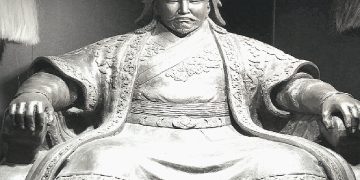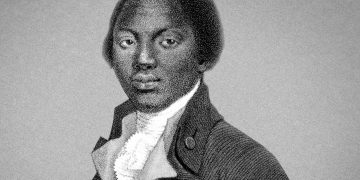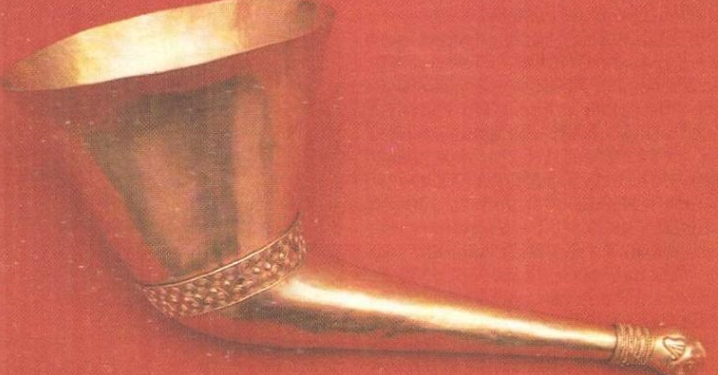What do we know about the Scythians
Ethnonym Scythians and its mention
The Scythians, like other peoples closely related to them, who lived in the 1st millennium BC. in the Eurasian steppes, did not have their own written language, and therefore their social and political history has to be recreated mainly on the basis of information stored in foreign cultural sources and according to archaeological data.
The name of the Scythians, known to us primarily from the writings of Greek and Latin authors, was used there in different meanings. Often, ancient writers referred to a wide range of peoples as Scythians who lived at that time in the vast expanses of the Eurasian steppe belt and had a largely similar culture. But a careful study of the use of this name in ancient sources testifies that only the inhabitants of the Northern Black Sea region and the Azov region called themselves so, or even initially only one tribe, in the first centuries of the 1st millennium BC. which subjugated the other population of this region and created on this basis a powerful alliance of tribes, which later grew into an early state formation. Greek settlers who started from the 7th century. BC. active colonization of the northern coast of the Black Sea, initially came into contact with this people. Over time, increasingly expanding the circle of their knowledge about the inhabitants of the Eurasian steppes and discovering in their culture and way of life much similar to what they already knew about the Scythians, the Greeks began to designate all the peoples of this circle by the name of the one who was familiar to them earlier and better than others. So the term “Scythians” acquired an expansive meaning. But many ancient authors retained an understanding of its specific ethno-historical meaning and distinguished the Scythians themselves from other steppe peoples, whose names were also known to them – from the Savromats, Massagets, Issedons, etc. who was familiar to them before and better than others. So the term “Scythians” acquired an expansive meaning. But many ancient authors retained an understanding of its specific ethno-historical meaning and distinguished the Scythians themselves from other steppe peoples, whose names were also known to them – from the Savromats, Massagets, Issedons, etc. who was familiar to them before and better than others. So the term “Scythians” acquired an expansive meaning. But many ancient authors retained an understanding of its specific ethno-historical meaning and distinguished the Scythians themselves from other steppe peoples, whose names were also known to them – from the Savromats, Massagets, Issedons, etc.
Tongue
Historical science of modern times has long shown attention to information about the Scythians preserved by the Greco-Roman tradition – in the works of Herodotus, Strabo, Pliny the Elder and other authors. Critical analysis of these texts acquired ever greater depth as the accumulation of archaeological data comparable to ancient evidence. Interest in the antiquities of the Black Sea Scythians awakened at the end of the 18th century. Modern science already has a fairly complete understanding of the history and culture of the Scythians and other peoples of the widely understood “Scythian world” of the Eurasian steppes.
Unfortunately, there are almost no data on the Scythian language. All scientists have at their disposal is a certain number of personal names and geographical names that have remained in foreign language texts. But even these remnants were enough to determine: the Scythian language belonged to the Iranian group, which is part of the Indo-Iranian branch of the Indo-European family of languages. The ethno-linguistic affiliation of other peoples of the Eurasian steppe belt remains more hypothetical, but some data are available on this score. So, about the Sauromats – the closest eastern neighbors of the Scythians – Herodotus reports that they allegedly originated from the marriages of Scythian youths with Amazons and speak the Scythian language, but “spoiled from ancient times.” In other words, the language of the Savromats is essentially a Scythian dialect. Separate surviving names and titles testify
Origin
The question of the origin of the Scythians is solved by a synthesis of written and archaeological data. Of the ancient authors, Herodotus writes about this in the most detail. According to his story, the Scythians came to the Black Sea region from Asia, displacing the Cimmerians from here. The message of Diodorus Siculus echoes this news, telling that the Scythians were once a weak and small people and lived on the banks of the Araks, but then they strengthened and conquered the Ciscaucasia and the entire northern coast of the Black Sea. Unfortunately, it is not clear which river Diodorus calls the Araxes – the ancient authors called different rivers that way, and therefore there are different opinions in science about the original habitat of the Scythians. Sometimes, relying on Herodotus, it is localized very far in the East, for example, in Central Asia. But if you remember that the ancient geographers considered the border between Asia and Europe r.
Most likely, the ancestral home of the Scythians was not east of the Volga basin (in some ancient sources it is called Ra, maybe this is the Araks?) Or, in extreme cases, the Urals. By the way, this assumption is in better agreement with the linguistic data on the zone of formation of the Iranian languages. In the pre-Scythian time in the Northern Black Sea and the Lower Volga regions, there were bearers of one archaeological culture – Srubnaya. Apparently, one of the movements within this culturally homogeneous area, archaeologically almost imperceptible, and is captured in the legend recorded by Herodotus and Diodorus.
Some stages in the history of the Scythians
Arrival in the Black Sea region
According to Herodotus, in the initial period of the history of the Scythians, they expelled all Cimmerians from their land. But this is not confirmed by archeology: much in the culture of the Scythians reveals a direct continuity from the culture of the Black Sea region of the previous period. Most likely, the Scythian union of tribes was formed in the course of the conquest by a tribe of closely related inhabitants of this territory that came from the east. It is possible that the conquerors were the direct ancestors of the Scythian tribes, which Herodotus in the 5th century. BC. knows under the name of “royal Scythians”, reporting that they dominate the rest of the Scythians, considering them their slaves. Probably, it was this tribe that originally was the carrier of the self-designation “Scythians”.
According to the story of Herodotus, after the conquest of the Black Sea region, the Scythians, pursuing the fleeing Cimmerians, invaded Southwest Asia. This message is corroborated by data from ancient Eastern texts, in which the invading people are referred to as “shkuda” – another transmission of the same ethnic name. More often, however, all the northern newcomers were called by the eastern scribes “Gimirri” – Cimmerians, and such a generalized naming of them best of all speaks for the fact that the Scythians and Cimmerians were ethnically and culturally close to each other. Most likely, in reality, there was not a one-time invasion of the inhabitants of the Black Sea region to the ancient East, but a gradual – in several waves – their penetration here starting at least from the end of the VIII century. BC.
Scythians in Western Asia
Throughout the VII century. BC. Scythian-Cimmerian military detachments actively participated in the political life of Western Asia, intervened in conflicts between states, supported some, and struck others. Later, having suffered a series of defeats, the Scythians left this region and returned to the Northern Black Sea region. From this time began about four hundred years of their domination in the Black Sea steppes. But the stay of the Scythians in the Middle East, acquaintance with the ancient Eastern civilization did not pass without leaving a noticeable mark in the appearance of the Scythian culture.
Before the aforementioned campaigns, the inhabitants of the Black Sea steppes (like other Indo-Iranian peoples in the early stages of their history) did not know the fine arts, limiting themselves to decorating their household and ritual utensils with the simplest geometric ornament. When, however, the social development of Scythian society, which especially accelerated just during the period of the conquest of the Black Sea region by the Scythians and their campaigns in Western Asia, required the creation of an artistic language designed to embody certain religious and mythological concepts associated with the concept of the hierarchical organization of society and the divine origin of the institution of royal power , for this purpose, images were used borrowed from the ancient oriental artistic repertoire.
Scythian culture
Animal style
Rethought in the spirit of the Scythian concepts proper, these images were fixed in the Scythian culture. For reasons not yet fully understood by researchers, various images of animals acquired the greatest popularity in Scythia, which served as the basis for the formation of the famous Scythian animal style – the most interesting and original element of Scythian culture. This art is characterized by the embodiment of strictly defined images – mainly ungulates, primarily deer, as well as feline predators and birds – depicted in several canonical poses. These motives were mainly used to decorate items of military equipment, horse harness, and ritual vessels. It is quite obvious that all these images had some important content in the eyes of the Scythians,
Some researchers are of the opinion that it is based on magical ideas – the desire to provide the owner of these images with those outstanding qualities that are inherent in embodied animals. Others associate them with Scythian mythology, believing that the Scythians thought of their gods as having a zoomorphic appearance. Sometimes the animal style is considered as a kind of symbolic sign system designed to embody general ideas about the structure of the universe. The question of the semantic load of the Scythian animalistic art requires further elaboration. Be that as it may, the art of the animal style, formed on the basis of the synthesis of ancient Iranian ideas about the world and ancient Eastern iconography, has become the most striking and original phenomenon of Scythian culture.
Folklore of the Scythians
Another event from the history of relations between the Scythians and the ancient East had a completely different character – their struggle against the invasion of the troops of the Persian king Darius I into their lands. The invasion of huge hordes threatened Scythia with great misfortunes. However paradoxical it may seem, this episode is of interest to us primarily not as an important page in the political history of the Scythians, but from the point of view of the study of Scythian culture. The fact is that the detailed story about this war, preserved by ancient authors (primarily by Herodotus), goes back, judging by a number of its features, to the Scythian oral epic tradition proper. The folklore of any nation reflects the most important aspects of the history of its culture, and its study is extremely important. Folklore of the Scythians is almost completely lost,
According to the tradition preserved by Herodotus, Darius, having crossed the Danube, for two months moved along the Black Sea steppes after the Scythians, who left without taking a fight. The attempt of the Persian king to challenge the Scythians to a decisive battle was unsuccessful. The Scythians motivated their refusal by the fact that, having neither cities nor cultivated lands to defend from the enemy, they do not see the need for an active struggle, but simply continue to lead their usual nomadic way of life. Nevertheless, they constantly harassed the Persians with small raids, causing significant damage to them. As a result, the army of Darius, having passed all over Scythia and some neighboring lands, was forced to flee from the Black Sea region, suffering heavy losses.
Apparently, this story contains very scant information about the real events of the Scythian-Persian war. Even the route described in it does not so much reflect the true course of hostilities, but is called upon to embody the idea of the total nature of the conflict and is dictated by the ritual and magical concepts of the ancient Iranian-speaking peoples. But this story contains interesting data about Scythian customs, ideas, cultural models. Remarkable is the magnificent figure of the Scythian leader, King Idanfirs, a wise ruler and military leader, which is typical of the ancient epic.
Scythian burial mounds
After repelling the Persian invasion, Scythia begins an almost two hundred year period of prosperity. The absolute majority of the Scythian monuments investigated by archaeologists belong to this time. These are mostly burial mounds. Their sizes vary within significant limits: small mounds were built over the burials of ordinary soldiers, which now – after centuries of plowing and weathering – barely rise above ground level; but over the graves of tribal leaders or kings, giant earthen hills were built, sometimes with the use of stone structures.
So, one of the most famous royal mounds of Scythia – Chertomlyk – on the eve of the excavations had a height of more than 19 m and a base circumference of 330 m, and the height of another mound – Aleksandropolskiy – exceeded 21 m. A grave was located under the mound of the mound. Most often this is the so-called catacomb – a kind of cave of a simple or complicated configuration, dug under one of the sidewalls of a deep (up to several meters) entrance well. There could be several such chambers in the burials of the nobility.
Funeral rite
The main equipment accompanying the deceased was located in the space of the chamber, and sometimes the entrance pit. In aristocratic burials, often here or in special additional graves, the bodies of servants buried together with the “lord” were laid – a squire, a groom, a maid, as well as riding horses intended for the deceased.
In the funeral ceremony of the Scythian leader, according to the story of Herodotus, all his subjects participated, by whose forces a giant embankment was erected. These same people were participants in the funeral feast, a memorial ritual, traces of which are often found during excavations. So, in the moat surrounding the Tolstaya Mogila mound (rich, although not too large), bones of so many domestic and wild animals eaten during the funeral were found, which suggests that approximately 2.5-3 thousand people took part in the funeral. person. The burial of an ordinary member of society was performed by his closest relatives and friends.
Inventory
The set of implements in Scythian graves is quite traditional, although in aristocratic mounds it is, of course, immeasurably richer than in ordinary ones. In male burials, these are primarily weapons. The validity of Herodotus’ remark that every Scythian is an equestrian shooter confirms the presence of bronze arrowheads in the grave, and sometimes the remains of the bow itself. The ancient authors compared the outlines of the Black Sea with the shape of the Scythian bow, the straight line of the southern coast of which corresponds to the bowstring, and the northern coast to the shaft with a bend in the place where the arrow’s hand was. How tight the Scythian bow was and what skill was required when handling it is evidenced by the myth preserved by Herodotus about the three sons of the ancestor of the Scythians, who, in order to choose from them a worthy pretender to the royal throne, as a test he invited them to pull the string over his bow; according to the Scythian tradition, only the youngest of the sons was able to succeed in this test.
Spears and akinaki swords were also common weapons among the Scythians, but the latter are more often found in aristocratic than in ordinary burials. In women’s graves, common finds are simple personal jewelry – earrings, rings, bracelets, and mirrors.
The set of objects found in the burials of the nobility is much more diverse. The main categories of things here are the same, but their types are more diverse, and the decoration is richer. The scabbard of akinaki and gorita – cases for bows and arrows – are often decorated with gold plates, equipped with ritual and mythological images. Lavishly decorated with gold overlays and a ritual female headdress. The clothes of the buried were embroidered with gold plaques with images and the bedspreads that hung the walls of the burial chamber. Ritual vessels of various shapes are very common in aristocratic burials – spherical goblets, rhytons, open bowls with two horizontal handles. Such vessels were made of precious metals or wood with metal plates. All these objects, in addition to indicating the extraordinary wealth of the Scythian aristocracy, are important to those
Influence of Greek masters
Many products of this type are not the products of the Scythian proper, but of the Greek masters. Since the Scythians themselves, in fact, did not know the visual arts, the Hellenic world was to create the pictorial incarnations of their myths. The formation of a specific Greco-Scythian art is a process in which both parties were equally interested: for the Scythians it was a way to obtain monuments embodying their ideological concepts, and for the Greeks it was to provide a market for their art and craft products.
To gain a foothold in this market, the Hellenic craftsmen not only imported their serial products into Scythia, but, adapting to the tastes and demands of the Scythian nobility, made monuments specially designed for sale in the Scythian environment. Various items of this series, obtained during the excavation of rich Scythian mounds and adorning museum collections in Russia and other states, in terms of stylistic appearance belong to the ancient artistic culture, embodying its highest achievements – dynamism, plasticity, authenticity and vitality in the transfer of the human and animal body. But in terms of content, most of the images decorating these objects are associated with the ideas inherent in the Scythian world, and therefore they serve as an invaluable source for the reconstruction of the ideological concepts inherent in the Scythians.
So, on the electric goblet from the Kul-Oba mound, excavated in the Crimea over 150 years ago, scenes of the already mentioned myth about the three sons of the Scythian ancestor are presented: two older brothers are depicted at the moment when they heal injuries received during unsuccessful attempts to pull the bowstring on the father’s bow, and the third of the brothers – to those who succeeded in this test. The same plot is depicted on a silver vessel from a burial mound excavated in the vicinity of Voronezh, but its pictorial interpretation, in this case, is different: we see the expulsion from the country of two eldest sons and the handing of the younger father’s bow as a symbol of power over Scythia.
The golden openwork pectoral from the Tolstaya Mogila mound deserves special attention. The Greek artist depicted on it a complex system of Scythian cosmological representations: the lower frieze of the three-tiered composition symbolizes the other world – the zone of domination of chaos and the forces of death, and the upper one – the world of people opposing chaos “space”. In the middle frieze, the wonderful interweaving of floral ornamentation symbolizes the “World Tree” connecting two so dissimilar worlds. In the central scene of the upper frieze, a ritual act is presented – the sewing of clothes from a sheep’s fleece, to which many peoples of antiquity attributed the magical ability to provide wealth and, in particular, the fertility of livestock.
There are also other ritual or mythological scenes in Greco-Scythian art. So, on a large silver vase from the Chertomlyk mound, the shoulders are decorated with scenes of a horse sacrifice in exact accordance with the description of this Scythian ritual, which was preserved by Herodotus.
Many ceremonial and ritual items from the Scythian burial mounds are equipped with images on the subjects of Greek myths and legends. Here you can find Hercules, Athena, Gorgon Medusa, episodes of the Trojan War. Sometimes these compositions are interpreted as evidence of the spread of Hellenic cults in the Scythian environment, but it is more likely that such images were reinterpreted by the Scythians, who interpreted them as illustrations to their own myths and the embodiment of their gods and heroes.
Scythian society and its decline
Religious representations of the Scythians
According to Herodotus, the seven main gods enjoyed special veneration among the Scythians. The first place among them belonged to Tabiti – the goddess of fire, the element, considered especially sacred among all Indo-Iranian peoples of antiquity. Following her in the Scythian religious and mythological hierarchy, a married couple was revered – the deities of heaven and earth Papaya and Api, who were considered the progenitors of people and the creators of the entire earthly world. Four gods of the third “category” personified, apparently, this earthly, bodily world. Among them, the best known to us is the god embodied in the ancient iron sword. His Scythian name has not reached us, but Herodotus describes in detail the ways of worshiping him. According to the historian, in each of the regions of the Scythian kingdom, a giant altar was erected from brushwood, dedicated to this god.
The common Scythian shrine was, apparently, a huge bronze cauldron located in the Exampey tract, in the interfluve of the Dnieper and the Southern Bug: according to Herodotus, this cauldron was cast from bronze arrowheads taken down here – one from each warrior – at the behest of the Scythian king Arianta, who thus wanted to find out the number of his subjects. The cauldron, of course, has not survived, but its shape can be judged by the numerous bronze cauldrons often found in Scythian burial mounds. As for the size of the cauldron located in Exampey, Herodotus’ data on this score are undoubtedly exaggerated and have a purely legendary character.
Social hierarchy
The tradition also includes the formation of the political structure of the Scythian kingdom, which was headed by three kings, to the mythical era of the first creation. Such a political organization existed, as we know, in the era of the Scythian-Persian war. Its collapse dates back to the middle of the 4th century. BC, when King Atey became the autocratic ruler of Scythia. The era of Atey, to which almost all the most famous rich Scythian burial mounds belong, is the period of the last rise in the power of the Scythians. The internal reasons for the subsequent decline of Scythia are not yet fully clear to researchers.
Sarmatian invasion
The external factors that contributed to this are better known to us. Thus, ancient sources have preserved information about a serious defeat inflicted on the Scythians in 339 BC. Philip of Macedon, when the Scythian ruler Atey himself died in the battle, by that time already a 90-year-old old man. But the main role in the collapse of Scythia was played by the invasion from the east, from the Ural steppes, by the Sarmatians – a people belonging to the same ethno-linguistic family as the Scythians. By the II century. BC e. the Sarmatians have already occupied the entire left bank of the Dnieper, and somewhat later penetrated the right bank of the Dnieper.
Describing the Sarmatian invasion of Scythia, Diodorus of Siculus reports that they devastated a significant part of it and, “without exception, exterminating the vanquished, turned most of the country into a desert.” Of course, this disaster could not destroy the entire population of Scythia. Remnants of the Scythian population survived, in particular, in numerous fortified settlements that arose at that time on both banks of the Dnieper. The culture of their inhabitants merged features inherited from the heyday of the Scythian kingdom, and those that were brought by the new population of the Black Sea region – the Sarmatians. But that was already a new page in the history of the region, known in sufficient detail.
Eurasian steppe belt
It is necessary to briefly touch upon the culture of those parts of the Eurasian steppe belt, which were located east of Scythia. Their material culture as a result of excavations of hundreds and thousands of burial mounds. It was the excavations that made it possible to reveal the cultural affinity of the inhabitants of the Eurasian steppes and the Black Sea Scythians, although each of the peoples of this circle also possessed specific, inherent cultural features. The mounds of the mentioned tribes were investigated in the lower reaches of the Syr Darya and in Central Kazakhstan, in the Tien Shan, Pamir and Altai, in the Minusinsk depression and even in East Turkestan.
Perhaps the most noteworthy are the monuments of the so-called Pazyryk culture found in Gorny Altai. The climatic conditions typical for the zone of distribution of the Pazyryk monuments, and the design features of the burial structures inherent in them, led to the formation of local lenses of permafrost in the area under the kurgan. This ensured the preservation in the graves of Pazyryk and some other burial grounds in the region of objects made from organic materials, usually crumbling in the ground without a trace. Among them are the clothes of the buried, ornaments and utensils made of carved wood, felt and pile carpets, etc. Even the bodies of the people buried here themselves, decorated with intricate tattoos, are well preserved by the permafrost.
With each generation, even with each field season, knowledge about the life, everyday life, culture of long-disappeared peoples is steadily replenishing.
The culture of the Meots – the neighbors of the Scythians in the Azov region
The newest remarkable finds are associated with the study of the monuments of the Kuban. The inhabitants of this region in the 1st millennium BC. there were tribes of Meots, which belong to the Ibero-Caucasian language family. The first mentions of Meots by ancient authors date back to the 6th century. BC. Judging by Herodotus, Strabo, and numerous epigraphic monuments of the Bosporus kingdom, these tribes lived in the Eastern Azov region and the Kuban.
In 1982-83. in Trans-Kuban, near the Adyghe aul of Ulyap, the Caucasian archaeological expedition of the State Museum of Oriental Art (State Museum of Oriental Art) under the leadership of A.M. BC. Of particular interest are several Meotian sanctuaries of the 4th century. BC, built on the already existing embankments of the Bronze Age. In the sanctuary of the Ulyap kurgan No. 1, among the numerous bones of animals and humans, there were a large number of various finds (bronze cauldrons, antique amphorae and bronze vessels, tools, details of horse dress, weapons, various gold jewelry). Of the greatest interest are two large gold plates in the form of figures of walking deer. The head, set directly on a mighty neck, is crowned with branchy horns, a surprisingly proportional body with long slender legs, as it were, is directed forward. Such are the Ulyap deer – a remarkable example of the Scythian-Meotian animal style, which combines a realistic interpretation of the figures of these noble animals with conventionally transmitted horns in the form of a bizarre combination of stylized griffin heads.












